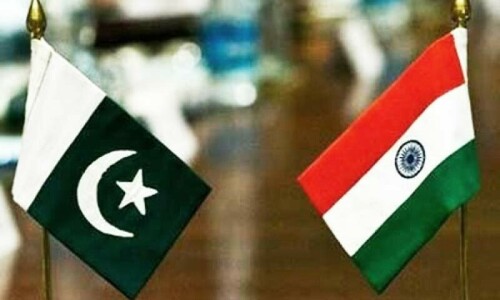THE Brussels terrorist attacks have made it evident that the militant Islamic State group (IS) is transforming into a global terrorist network. The group’s weakening territorial control in Iraq and Syria could be one reason for this transformation. But the most important factor is that the group is losing its attraction among Islamist militant movements mainly due to its ultra-violent sectarian credentials.
The so-called Khorasan chapter of IS also appears to be on the retreat in Afghanistan and Pakistan. In Afghanistan, its affiliates and supporters have suffered heavy military losses at the hands of the Afghan Taliban, and in drone attacks and operations by the Afghan security forces. Similarly in Pakistan, extensive surveillance and intelligence-based operations have helped law enforcers bust many terrorist cells established by individuals who were either affiliated with or inspired by IS.
Importantly, the group is losing its appeal and credibility among most militant groups in Pakistan and Afghanistan because of its extremely narrow sectarian views. Even the Deobandi militant groups — who largely control the militant discourse and infrastructure in the region — find it hard to reconcile with IS’s criteria of ‘righteousness’.
Many analysts are surprised at what they see as an early and fast deterioration of the group. Others, however, interpret it as a process of reconstruction which is transforming the group from a local Islamist militant movement to a global terrorist group. As a terrorist group, IS will pose a bigger threat to global security as compared to Al Qaeda, due to abundant human resources and the strong logistical support base it enjoys, especially in the West, from where the group has taken thousands of youths into its fold.
IS may be losing its appeal among militant groups in Pakistan but the danger remains.
Bruce Hoffman, a renowned expert on terrorism, was quoted in a recent international publication as saying that even if IS dispatches only 10pc of foreign fighters to their native lands, we would see the foundation of a potentially highly effective terrorist cell and support network. Another expert, Andrew Watkins, believes that although IS has set up a unit dedicated to international attack plotting, the threat which can come from IS affiliates, loosely organised supporters, or those inspired online, would be more challenging as such cells may not be fully under the control of the IS central command.
There is another aspect of this IS transformation. Al Qaeda affiliates in different regions can take a weakening IS as an opportunity to attract its disillusioned members and engage them in terrorist operations. That would mean that it could also provide a lifeline to weakening terrorist movements, in a similar way when in 2014 Al Qaeda chapters and allies were not satisfied with the central leadership and felt attracted towards IS.
It can also be seen in another context. An ideologically inspired movement can divide into factions representing different tendencies and shades, but at a stage, these factions start complementing each other. This is not a new story in the South Asian context, where militant movements are in a constant state of evolution.
The Muslim countries cannot take this as ‘someone else’s problem’ as their youth are engaged with IS, which can at any time trigger a wave of violence in their native countries. Turkey, Tunisia and other North African Muslim nations have already started to suffer at the hands of IS-inspired militants. This should be taken as a serious warning by Muslim countries that already have an active militant infrastructure.
The situation in Pakistan and Afghanistan is yet more complex. IS has challenged the theological framework of the Deobandi brand of Islam in the region and also questioned the ideological basis of the Taliban movement. The group tagged the Taliban movement as a nationalist one, which it believes does not qualify as a ‘caliphate’ movement.
In the beginning, IS had received an overwhelming response from militant groups in the region but could not sustain it because of its obsession with ‘correcting’ the religious practices of these groups and converting them to Salafism. IS distributed many religious decrees against Deobandi Islam, but a publication titled Risalatul fil Deoband (A Book for Deoband) created real resentment against IS.
The Taliban commanders, who were feeling attracted to the newly emerged movement, started reconsidering their decisions. The Central Asian groups, descendants of Hizb-i-Islami and Salafi Taliban from Kunar and Nuristan regions of Afghanistan, were already inclined towards Salafi tendencies and took over the leadership of IS in some parts of Afghanistan. But these groups, mainly the Islamic Movement of Uzbekistan, faced hard resistance from the Afghan Taliban.
This has stopped the IS advance for a while, but the group has already transformed the militant character of the region. The young Taliban commanders feel more attracted to establishing an Islamic ‘caliphate’ and their belief that they can take over Afghanistan is becoming firmer.
Obviously, this transformation will have a negative impact on the reconciliation process in Afghanistan. The central Taliban leadership and senior commanders, who see an advantage in the political process, will face resistance from this young lot.
As far as Pakistani Taliban groups are concerned, IS had provided them ideological and political support when they were facing internal challenges and military operations by Pakistani security forces. Jamaatul Ahrar, which showed an inclination towards the Middle Eastern group and modified its organisational and operational framework along IS lines, has emerged as a new threat to Pakistan’s security. The group has claimed responsibility for most of the terrorist attacks in Pakistan over the past few months. The group had never formally joined the IS. At present, it has developed a nexus with Al Qaeda in the Indian Subcontinent, which is another beneficiary of a weakening IS in the region.
That does not mean that the days of IS are numbered in the world and in our region. The group can review its strategies to regain its lost attraction. At the same time, the group still remains an inspiration for militants as well as religious segments of society with Salafi inclinations, small but highly motivated Islamist groups, and politically charged youth in cyberspace.
The threat is not going away but taking a new turn.
The writer is a security analyst.
Published in Dawn, March 27th, 2016













































